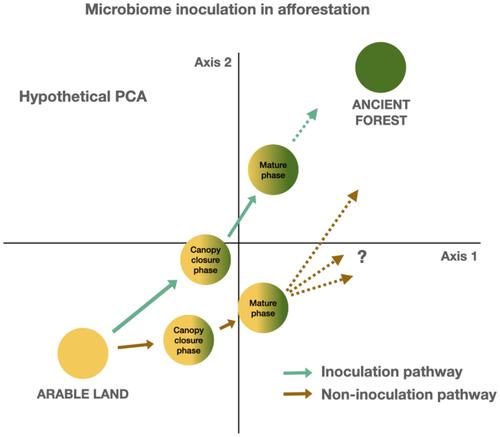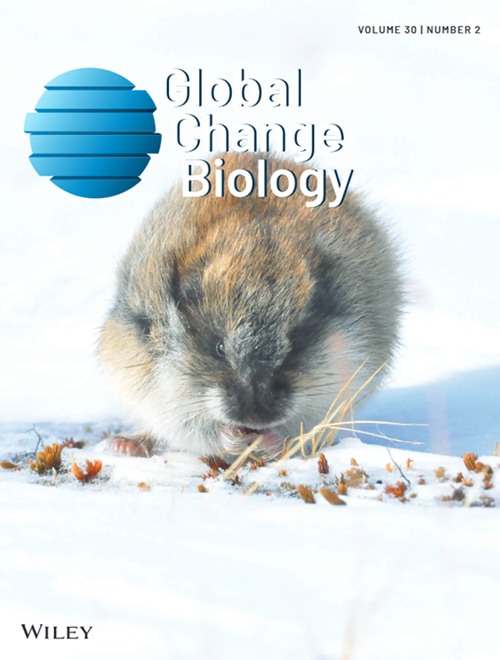后农业景观中弹性多功能新林土壤微生物群接种研究
IF 10.8
1区 环境科学与生态学
Q1 BIODIVERSITY CONSERVATION
引用次数: 0
摘要
造林日益被认为是恢复生态系统和增强农业后景观生物多样性的关键战略。然而,农业遗留问题,如土壤结构的改变、营养失衡和微生物多样性的枯竭,可能会减缓森林的建立或导致生态系统偏离预期的演替轨迹。在这篇观点论文中,我们探索了土壤接种作为一种工具的潜力,通过引入有益的微生物群落来克服这些挑战,从而加速生态系统的恢复和森林的发展。恢复土壤生物多样性是这一进程的一个关键方面,它能推动更广泛的生态系统功能和复原力。我们强调需要仔细考虑接种的类型和时间,并确保接种物和受体位点特征之间的兼容性,以优化引进物种的建立。虽然树木生产力往往是造林工作的中心重点,但恢复土壤生物多样性也应成为森林长期恢复力的优先事项,因为土壤生物多样性也将有助于增加生态系统一级的功能。农业遗产增加了恢复过程的复杂性,创造了需要在恢复规划中解决的独特挑战。因此,成功的接种策略需要彻底了解供体和受体位点的特征,以及与土壤理化性质相关的潜在不匹配,以避免诸如未建立引入物种等意想不到的后果。此外,我们呼吁重新评估造林目标,并制定标准化的监测方案,以跟踪接种工作的成功,特别是在土壤健康、微生物群落建立和生物多样性恢复方面。通过在更广泛的恢复框架内整合接种实践,我们可以增强新造林景观的恢复力、生物多样性和生态系统功能。最终,这种方法可能在确保大规模造林项目的成功方面发挥关键作用。本文章由计算机程序翻译,如有差异,请以英文原文为准。

Soil Microbiome Inoculation for Resilient and Multifunctional New Forests in Post-Agricultural Landscapes
Afforestation is increasingly recognized as a critical strategy to restore ecosystems and enhance biodiversity on post-agricultural landscapes. However, agricultural legacies, such as altered soil structure, nutrient imbalances, and depleted microbial diversity, can slow down forest establishment or cause ecosystems to deviate from expected successional trajectories. In this opinion paper, we explore the potential of soil inoculations as a tool to overcome these challenges by introducing beneficial microbial communities that can accelerate ecosystem recovery and forest development. Restoring soil biodiversity is a crucial aspect of this process that drives broader ecosystem functionality and resilience. We highlight the need to carefully consider the type and timing of inoculations and to ensure compatibility between the inoculum and recipient site characteristics to optimize the establishment of introduced species. While tree productivity is often a central focus of afforestation efforts, the restoration of soil biodiversity, which will also contribute to increased ecosystem-level functions, should also be a priority for long-term forest resilience. Agricultural legacies add complexities to the restoration process, creating unique challenges that need to be addressed in restoration planning. Thus, successful inoculation strategies require a thorough understanding of both donor and recipient site characteristics, also in relation to potential mismatches related to soil physiochemical properties to avoid unintended consequences such as the non-establishment of introduced species. Additionally, we call for the re-evaluation of afforestation targets and the development of standardized monitoring protocols that track the success of inoculation efforts, particularly regarding soil health, microbial community establishment, and biodiversity recovery. By integrating inoculation practices within a broader restoration framework, we can enhance the resilience, biodiversity, and ecosystem functionality of newly afforested landscapes. Ultimately, this approach may play a critical role in ensuring the success of large-scale afforestation projects.
求助全文
通过发布文献求助,成功后即可免费获取论文全文。
去求助
来源期刊

Global Change Biology
环境科学-环境科学
CiteScore
21.50
自引率
5.20%
发文量
497
审稿时长
3.3 months
期刊介绍:
Global Change Biology is an environmental change journal committed to shaping the future and addressing the world's most pressing challenges, including sustainability, climate change, environmental protection, food and water safety, and global health.
Dedicated to fostering a profound understanding of the impacts of global change on biological systems and offering innovative solutions, the journal publishes a diverse range of content, including primary research articles, technical advances, research reviews, reports, opinions, perspectives, commentaries, and letters. Starting with the 2024 volume, Global Change Biology will transition to an online-only format, enhancing accessibility and contributing to the evolution of scholarly communication.
 求助内容:
求助内容: 应助结果提醒方式:
应助结果提醒方式:


